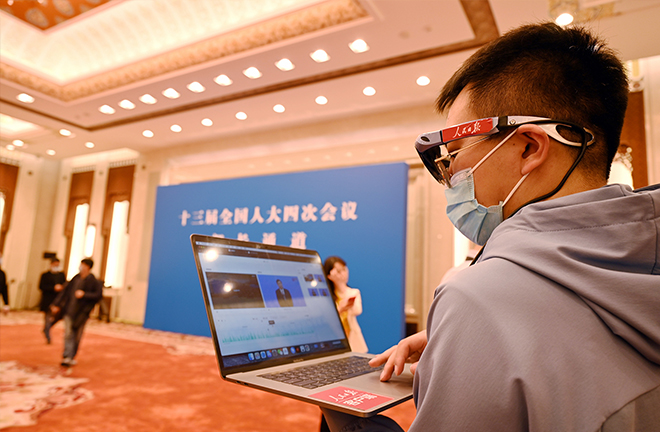Understanding journalism in digital age

A reporter does cloud-based video editing to report on the fourth session of the 13th National People’s Congress in Beijing in March, 2021 Photo: CFP
The development of communication technology has promoted the deep digitization of news production models. Media’s technological change constantly challenges the explanatory framework and interpretive ability of traditional theories.
The revolution of the internet and digital technology continues to expand the boundaries of journalism, and journalism in the platform era has a wider group of participants.
Shi Anbin, deputy dean of the School of Journalism and Communication at Tsinghua University, said that digital news production driven by internet technology is an important subject and motivation for changes in, and exploration of, contemporary news discourse. Digital journalism opens new storytelling methods and fuels the rise of cross-media storytelling and media convergence. In addition, it changes the news production process, greatly speeds up information production and dissemination, and allows audiences to track the latest information anytime, anywhere.
In the 1950s and 1960s, with the widespread use of television communication technology in the journalism industry, many influential news communication theories were developed. Chang Jiang, a professor from the School of Media and Communication at Shenzhen University, said that the popularization of the internet has also produced a similar effect. Interactions between users and the news ecology have been enhanced, and the “audience” in the traditional sense has become more active in news production, which will definitely bring about new developments in digital journalism’s theoretical paradigm.
Based on shared understanding of our common information ecology, journalism researchers have the responsibility to make journalism a discipline with universal explanatory power for social and historical laws.
After conducting an in-depth investigation into 45 senior journalism researchers from eight countries using the Delphi method [an in-depth systematic qualitative methodology that consists of several rounds of written questionnaires which collect expert opinions], Chang highlighted four consensuses on digital journalism theories in the academic community. On this basis, he explored the concept system construction for digital journalism.
Chang believes that digital journalism is based on the “symbiosis of technology and culture” as its epistemological basis, with the two basic categories of news ecology research and news actor research. Having the facets of a normative theory with professionalism as its core discourse and information democracy as its value goal, digital journalism is a new paradigm for journalism, which has been developed under new technologies and historical conditions.
By integrating the inverted pyramid structure [the organization of news with the most important information first] and the tumbled pyramid [wherein the news builds from a level of less information to increasingly deeper and varied information levels on the theme], Shi and his team proposed a “pyramid” structure based on social media [with integrated multimedia reporting on top of the base layer of social media reporting, and traditional media reports at the very top of the structure]. At the same time, by analyzing the linkage effect of traditional media and new media, as well as that of domestic and foreign public opinion fields showcased in successful media reports in China, a “ripple effect” model of all-media news dissemination is constructed, with hopes of creating a journalism discourse system for the industry that integrates China and the world.
The transformation of journalism’s practice and format has prompted the academic community to reflect on the existing journalism discourse system and explore new theories and concepts. Ji Weimin, a professor from the School of Journalism and Communication from the University of Chinese Academy of Social Sciences, called for the correct handling of the relationship between global perspectives and local academic research, on the basis of clarifying research traditions, so as to promote theoretical deepening and innovation.
“One of the core issues is how to reasonably share and use news,” Ji noted. Ji suggested focusing on news consumption, the right to know, and media literacy education at the individual level. At the organizational level, it is necessary to research such topics as news bias and discrimination, and the use of news.
“Future digital journalism will consist of five elements: platforms, algorithms, big data, alternative media, and social media robots. News discourse should explore multiple frameworks, and constantly review and ponder the relationship between news discourse and technology in the practice of global digital journalism,” Shi concluded.
Edited by JIANG HONG
